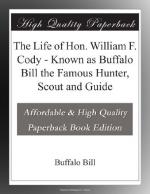[Illustration: A DUEL WITH CHIEF YELLOW HAND.]
While at the agency I learned the name of the Indian Chief whom I had killed in the morning; it was Yellow Hand; a son of old Cut-nose—a leading chief of the Cheyennes. Cut-nose, having learned that I had killed his son sent a white interpreter to me with a message to the effect that he would give me four mules if I would turn over to him Yellow Hand’s war-bonnet, guns, pistols, ornaments, and other paraphernalia which I had captured. I sent back word to the old gentleman that it would give me pleasure to accommodate him, but I could not do it this time.
The next morning we started to join General Crook, who was camped near the foot of Cloud Peak in the Big Horn mountains; awaiting the arrival of the Fifth Cavalry, before proceeding against the Sioux, who were somewhere near the head of the Little Big Horn,—as his scouts informed him. We made rapid marches and reached General Crook’s camp on Goose Creek about the 3d of August.
At this camp I met many old friends, among whom was Colonel Royal, who had received his promotion to the Lieutenant Colonelcy of the Third Cavalry. He introduced me to General Crook, whom I had never met before, but of whom I had often heard. He also introduced me to the General’s chief guide, Frank Grouard, a half breed, who had lived six years with Sitting Bull, and knew the country thoroughly.
We remained in this camp only one day, and then the whole troop pulled out for the Tongue river, leaving our wagons behind, but taking with us a large pack train. We marched down the Tongue river for two days, thence in a westerly direction over to the Rosebud, where we struck the main Indian trail, leading down this stream. From the size of the trail, which appeared to be about four days old, we estimated that there must have been in the neighborhood of seven thousand Indians who had made the broad trail.
At this point we were overtaken by Jack Crawford, familiarly known as “Captain Jack, the Poet Scout of the Black Hills,” and right here I will insert the following lines, written by him, just after the “Custer Massacre,” upon receiving from me the following dispatch:
“Jack, old boy, have you heard of the death of Custer?”




